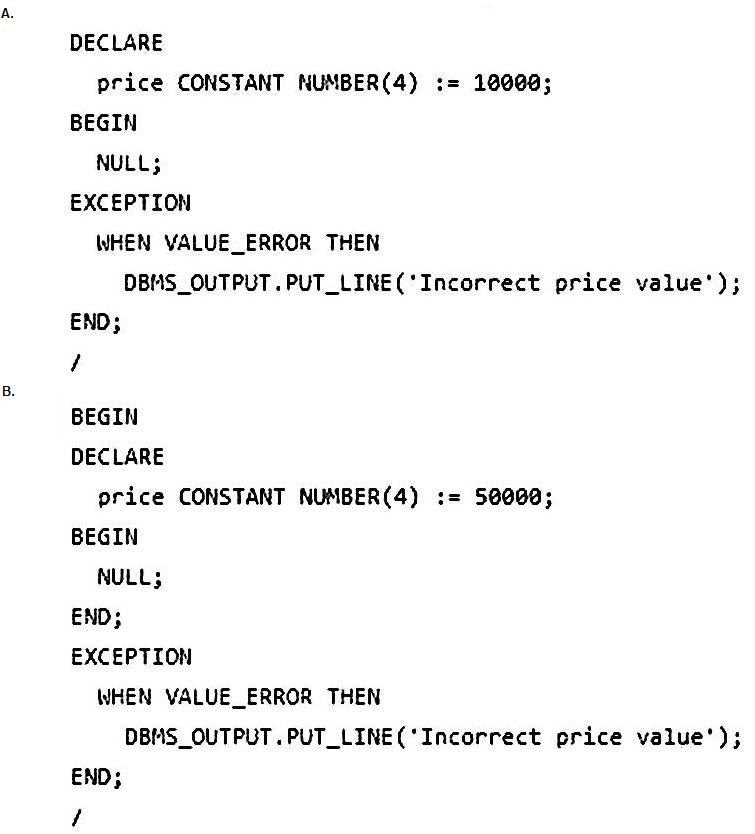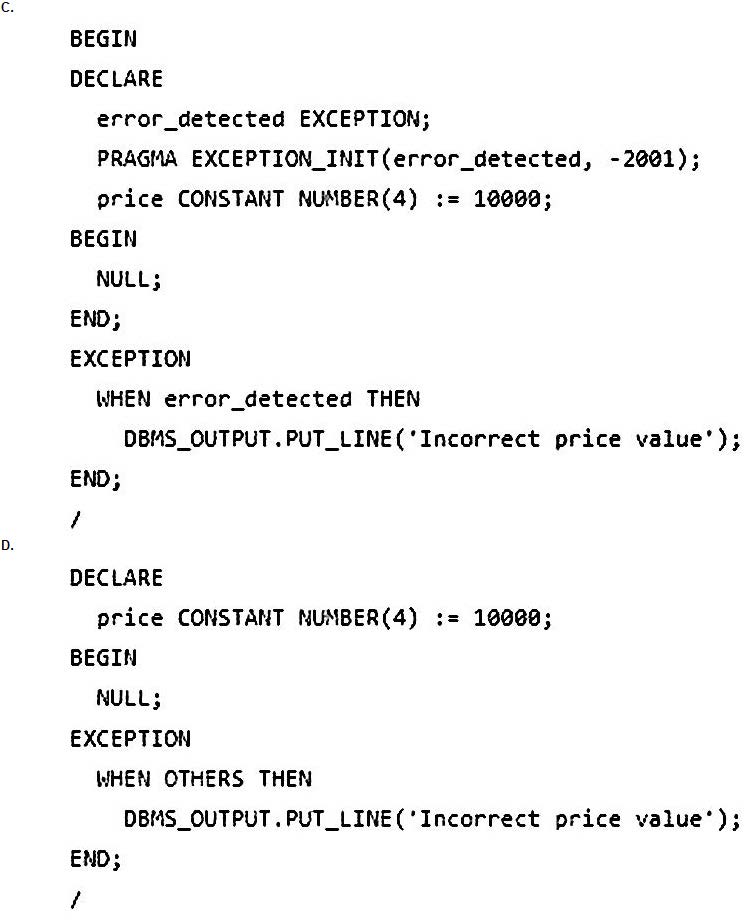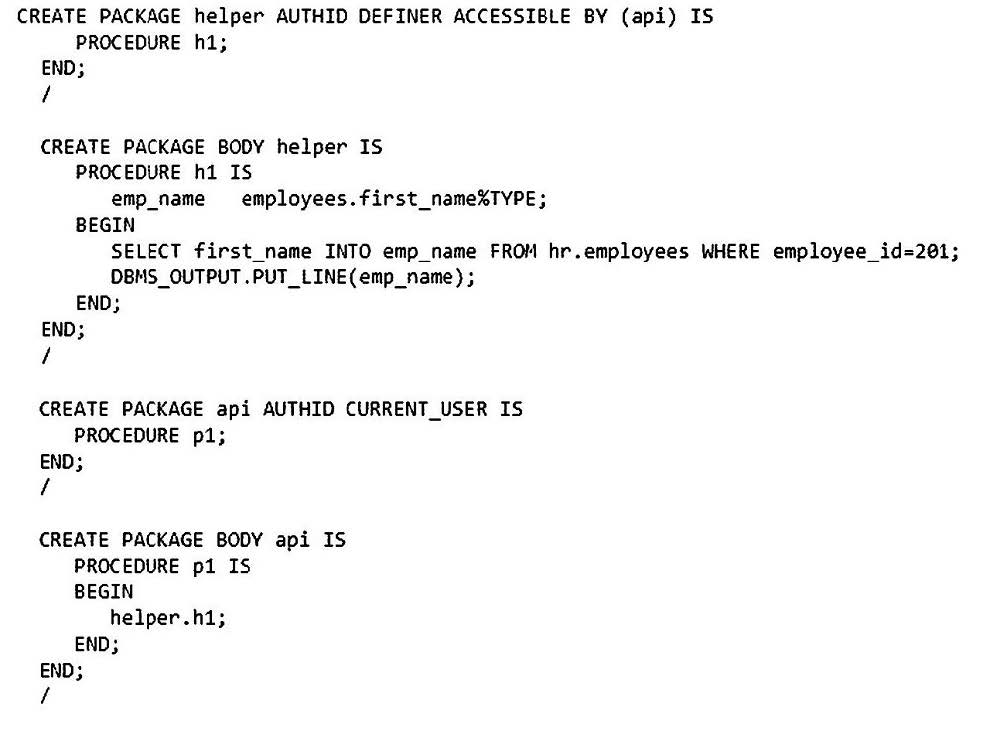Exam Details
Exam Code
:1Z0-149Exam Name
:Oracle Database Program with PL/SQLCertification
:Oracle CertificationsVendor
:OracleTotal Questions
:65 Q&AsLast Updated
:Jun 29, 2025
Oracle Oracle Certifications 1Z0-149 Questions & Answers
-
Question 11:
Which block of code displays the error message "Incorrect price value"?


A. Option A
B. Option B
C. Option C
D. Option D
-
Question 12:
Which three are true about functions and procedures? (Choose three.)
A. The ACCESSIBLE BY clause can be used only for procedures.
B. In a function, every execution path must lead to a RETURN statement.
C. Both can have only constants as actual parameters for IN mode parameters.
D. Both can be invoked from within SQL statements.
E. In a procedure the RETURN statement cannot specify an expression.
F. In a function every RETURN statement must specify an expression.
-
Question 13:
Which two are true about lexical units? (Choose two.)
A. Character literals are case-sensitive.
B. Spaces can be embedded in delimiters.
C. Identifiers include labels.
D. A character literal with zero characters has the BOOLEAN value NULL.
E. All user-defined identifiers must start with an alphabet.
-
Question 14:
Which three are true about PL/SQL subprograms? (Choose three.)
A. Results of a subprogram can be cached in the SGA such that sessions connected to the same instance can reuse these results when available.
B. Users granted execute privilege on a procedure compiled with definer's rights require grants to access objects belonging to the definer that are referenced in the procedure.
C. Subprograms are cached by default and shared among users, thereby reducing memory requirements.
D. Reuse of parsed PL/SQL code from the shared SQL area reduces parsing overhead.
E. A subprogram's session state is retained even if any of the session's instantiated subprograms are invalidated and revalidated.
F. Host variables can be referenced inside any PL/SQL subprogram.
G. A PL/SQL procedure can invoke an external code block written in a different programming language.
-
Question 15:
Which three statements can process a dynamic multi-row query? (Choose three.)
A. DECLARE
B. OPEN
C. INTO
D. OPEN-FOR
E. FETCH
F. WHEN
G. CLOSE
-
Question 16:
Which three are true about the procedure overloading feature? (Choose three.)
A. Each procedure can be a nested subprogram.
B. Each procedure's formal parameters can differ in data type or name.
C. Each procedure must use named notation to specify the corresponding actual parameters.
D. Each procedure's formal parameters must differ in name.
E. Each procedure can be a packaged subprogram.
F. Each procedure must use positional notation to specify the corresponding actual parameters.
G. Each procedure can be a standalone subprogram.
-
Question 17:
Which three statements are true about Implicit Cursor and Explicit Cursor? (Choose three.)
A. Implicit cursor returns only one record.
B. Explicit cursor can return more than one record.
C. %Isopen, %Rowtype, %Notfound, and %Found are the attributes of Explicit Cursor.
D. %Isopen, %Rowcount, %Notfound, and %Found are the attributes of Explicit Cursor.
E. %Isopen, %Type, %Notfound, and %Found are the attributes of Explicit Cursor.
F. %Isopen is always false in Explicit Cursor.
G. %Isopen is always false in Implicit Cursor.
-
Question 18:
In one of your databases, table HR.EMPLOYEES includes the columns FIRST_NAME and EMPLOYEE_ID.
A row exists with EMPLOYEE_ID 201.
Examine these packages created by user HR:

EXECUTE privilege is granted to user SH, on the HR.API and HR.HELPER packages.
Which two will execute successfully? (Choose two.)
A. Call HR.HELPER.H1 from the HR schema.
B. Call HR.HELPER.H1 from the SH schema.
C. Call HR.API.P1 from the HR schema.
D. Call HR.API.P1 from the SH schema.
E. Create and call a package procedure API.H1 in the SH schema, which calls HR.HELPER.H1.
-
Question 19:
Which two are valid MODIFIER values for the PLSQL_WARNINGS parameter? (Choose two.)
A. DISABLE
B. ENABLE
C. ERROR
D. ALL
E. SEVERE
-
Question 20:
Which three are true regarding code based access control (CBAC)? (Choose three.)
A. In a multitenant environment, the DELEGATE option of CBAC cannot be used.
B. CBAC roles can be granted to a program unit only if they are directly granted to its owner.
C. CBAC roles can be granted to a program unit only if they are the predefined roles automatically defined by the standard scripts as part of database creation.
D. You can use CBAC to attach database roles to a PL/SQL function or procedure only.
E. In CBAC, the ADMIN and DELEGATE options cannot both be granted to the same user.
F. You can use CBAC to attach database roles to a PL/SQL function, procedure, or package.
G. CBAC cannot be used to secure definer's rights.
Related Exams:
1Z0-020
Oracle8i: New Features for Administrators1Z0-023
Architecture and Administration1Z0-024
Performance Tuning1Z0-025
Backup and Recovery1Z0-026
Network Administration1Z0-034
Upgrade Oracle9i/10g OCA to Oracle Database OCP1Z0-036
Managing Oracle9i on Linux1Z0-041
Oracle Database 10g: DBA Assessment1Z0-052
Oracle Database 11g: Administration Workshop I1Z0-053
Oracle Database 11g: Administration II
Tips on How to Prepare for the Exams
Nowadays, the certification exams become more and more important and required by more and more enterprises when applying for a job. But how to prepare for the exam effectively? How to prepare for the exam in a short time with less efforts? How to get a ideal result and how to find the most reliable resources? Here on Vcedump.com, you will find all the answers. Vcedump.com provide not only Oracle exam questions, answers and explanations but also complete assistance on your exam preparation and certification application. If you are confused on your 1Z0-149 exam preparations and Oracle certification application, do not hesitate to visit our Vcedump.com to find your solutions here.